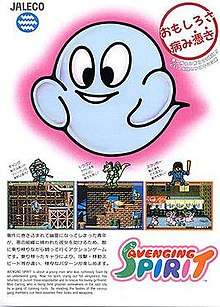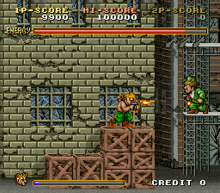Avenging Spirit
Avenging Spirit, known in Japan as Phantasm (ファンタズム), is a 1991 2-player platform arcade game developed by C.P. Brain and published by Jaleco.
| Avenging Spirit | |
|---|---|
 Promotional flyer for Avenging Spirit | |
| Developer(s) | C.P. Brain |
| Platform(s) | Arcade game, Game Boy, 3DS Virtual Console |
| Release | ArcadeGame Boy3DS Virtual Console
|
| Genre(s) | Platform game |
| Mode(s) | Single player, Up to 2 players, alternating turns |
| Cabinet | Horizontal |
| Arcade system | Jaleco Mega System 1-B hardware |
| CPU | 68000 |
| Sound | Sound CPU : 68000 Sound Chips : YM2151, OKI6295 |
| Display | Raster, 256 x 224 pixels, 1024 colors |
Plot
During a walk with his girlfriend, the player is ambushed by agents of a mysterious crime syndicate who take his girlfriend away and shoot him to death. Now, as a wandering spirit with the ability to possess most others, he is summoned by his girlfriend's father (who researches ghost energy) and is given a mission to save her from the mysterious crime syndicate that holds her hostage, enabling the player to rest in peace.[1]

As it turns out, the crime syndicate is also researching ghost energy, and they kidnapped the girl in an effort to force her father to cooperate with them. The player must fight through 6 stages to infiltrate the evil syndicate's base, collecting three keys on stages 2, 5, and 6. If the player has all three keys upon reaching the final leg of Stage 6, he can open the girl's cell and possess her to help her fight her way out. If not, he must abandon her and face the syndicate's leader alone. After the syndicate's leader is defeated, the base blows up, and the player ends up on a grassy field as his spirit's power fades. If the player failed to save the girl she [probably] dies in the explosion and he expects to see her in afterlife as he fades away. If the player did save her, she comes to on said grassy field, and the player expresses a wish for her future happiness as he vanishes.
Gameplay
Players can possess one of four characters with unique abilities at the start of the game, but the library of enemies expands and changes with each level. Players attack (or possess) enemies, collect power-ups, and defeat bosses to advance.
Reception
In Japan, Game Machine listed Avenging Spirit on their July 1, 1991 issue as being the seventeenth most-successful table arcade unit of the year.[2]
Sinclair User called Avenging Spirit a "superior action game with a rather odd scenario." They praised the longevity of the game but admitted that it had a steep learning curve that might not appeal to more casual players.[1] British gaming magazine The One reviewed Avenging Spirit in 1991, stating that it "isn't destined to be a classic", but it has "originality and nice touches".[3]
Ports and re-releases
On December 14, 2010, DotEmu released an iOS port of the game on the Apple AppStore. The Game Boy version was re-released on the Nintendo eShop's Virtual Console download service on August 11, 2011.
References
- "Coin Ops: Avenging Spirits Review". Sinclair User. No. 113. July 1991. p. 39.
- "Game Machine's Best Hit Games 25 - テーブル型TVゲーム機 (Table Videos)". Game Machine (in Japanese). No. 406. Amusement Press, Inc. 1 July 1991. p. 29.
- "Arcades: Avenging Spirits Review". The One. No. 34. emap Images. July 1991. p. 83.